FAQ
- Bolivia climbing questions
-
Mallorca island and rockclimbing
- What are main specifics of rockclimbing trip to Mallorca
- Mallorca island impressions
- Rockclimbing safety Spain
- Mallorca climbing accommodation
- What season is possible for rockclimbing in Mallorca
- Transport accessibility of climbing sectors in Mallorca
- Active vacation in Mallorca
- Saint Anthony night in Mallorca
- Peru climbing questions
- Gear reviews
-
Safety in the mountains
- How NOT to climb the summit?
- Mountain navigation
- At the limit of possibilities
- Mountain thunderstorm
- Solo ascents and mountain trips alone
- Mutual responsibility in mountaineering
- Safety illusions in the mountains - a rope
- Independent team of two
- Mountain troubles
- Psychological problems in the mountains
- Health in the mountains
-
Elbrus questions
- Elbrus climbing gear
- Climbing Elbrus with children?
- Mount Elbrus location?
- Elbrus logistics
- How to get to Mount Elbrus?
- Elbrus German airfield?
- Elbrus difficulty grade
- 5 points beginner must know about Elbrus
- How to prepare for Elbrus?
- Are there avalanches on Mount Elbrus?
- Climbing Elbrus solo?
- Seasonality of climbing Mount Elbrus
- How much time climbing Elbrus takes?
- Clothes for Mount Elbrus?
- Pressure at the top of Elbrus?
- Elbrus air temperature
- Elbrus sightseeing
- How much to climb Elbrus
- Gear questions
- Mountaineering questions
- Mountain climbing training
-
Rockclimbing questions
- Rockclimbing gear
- How to choose your first rockclimbing shoes
- The hand power in roclcimbing
- What is Rockclimbing tours
- Non olymnic rockclimbing
- What is rockclimbing?
- Where do you climb?
- Where and when we organize our rockclimbing programs?
- What is rockclimbing?
- Rockcliming program class?
- Climbing motivation
- Horse riding tours
- Iceclimbing questions
-
Questions on the alpine programs
- What to climb in Morocco?
- Weekend summit climb
- Georgia 2023
- Pico Aneto - what is that mountain?
- Mountain programs format
- Mountain climbing food ration
- Queries on the alpine program climbing Mount Bazarduzu
- Queries on the Kamchatka alpine program climbing
- What is combined program?
- What is sightseeing program?
- What is pilot program?
- What programs you have of the medium complexity level?
- Basic expedition rations
- Prices for the mountain climbing programs
- Queries on the Mountain Course in Adyl Su valley
- Program complexity?
- Questions about MCS AlexClimb
- Questions related to trekking programs
Solo tours in Cordillera Blanca
Peru, Cordillera Blanca - self-guided hikes
Options for independent or solo travel in the mountains of Peru - Cordillera Blanca.
Read in Telegram in English
Leer en Telegram en Espñol
Regarding the topic of solo mountaineering or solo hiking in the mountains, I have already expressed my opinion in a separate article in the Safety in the mountains section.

Amazing mountain landscapes of Peru - a combination of snow-white peaks and colorful lakes
Nevertheless, many of my friends, who do not have sufficient flexibility in choosing dates, or with a limited budget, still prefer independent travel to the group organized programs. How to make it so, that the violation of the basic safety rules in the mountains would be at least less dangerous and would not lead to undesirable consequences.
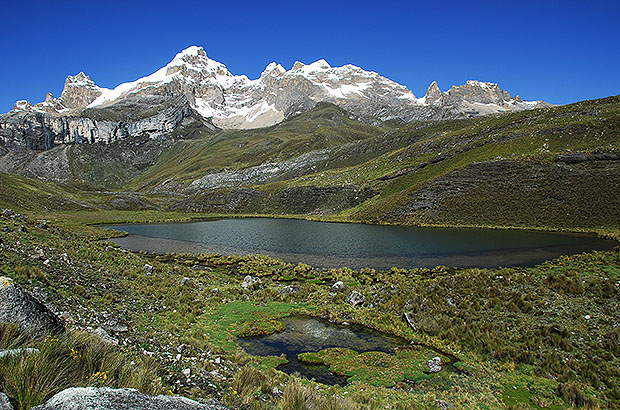
If you take a roll of fishing line and a spinner with you, you will have the opportunity to catch trout
First of all, you need to understand and reasonably assess the risks associated with the proposed route, the level of your training, the availability of an appropriate set of clothing, navigation equipment, the necessary camping gear and emergency communication channels in case of an unforeseen situation.
Which is absolutely undiscussable - any route options in the mountains, associated with the need to organize belay, overcome technical obstacles or objectively dangerous areas, are completely unacceptable for solo hikes or trips.

It is good to be alone in the mountains, but in a friendly team it’s better and safer
Thus, routes in the remote areas, passing through large deserted areas without marked trails, through crevassed glaciers, routes along the avalanche slopes, crossings of mountain rivers - all these options should not be considered if you are going to the mountains alone or in a weak independent group.
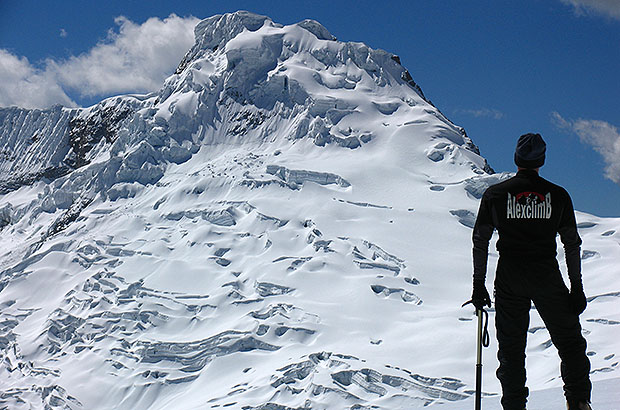
The most reliable travel option is to go to the mountains with an experienced MCS AlexClimb guide
On the other hand, conditionally favorable conditions for independent trips in the mountains can be called:
- the presence of marked trails on the route
- availability of emergency radio channels and (or) stable coverage of the area by cellular operators
- high popularity of the area and presence of other groups on the routes
These factors are not a guarantee of your safety in the mountains. In any case, regardless of their presence, going on a route alone, you expose yourself to significantly higher risks than in an organized group.

View of Nevado Huascaran from Yungai Memorial Complex
Returning to the declared topic of this section - the specifics of mountain travel in the Cordillera Blanca. The peculiarity of this region of Peru is that there is a well-developed tourist infrastructure. The main routes are qualitatively marked and, during the season (May - September), are actively visited by tourist groups. There are comfortable shelters on the routes, where you can get basic paid services - accommodation, meals, advice on the state of the route, organizing transportation, etc.
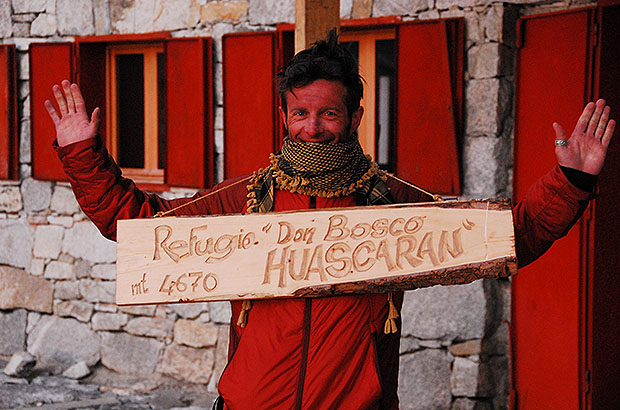
In the Don Bosco Huascaran climbing shelter
The most of the tourists are mostly English-speaking, therefore, even if you do not speak Spanish, if necessary, you can find a way to communicate. The main part of the tourist audience on routes in the Cordillera Blanca are commercial groups. This business format is very developed in the area, so if necessary, you can always translate the “independent” format into a more comfortable and safe type of a trip. Naturally, doing this on the route or at the last moment that will cost more than with timely planning.
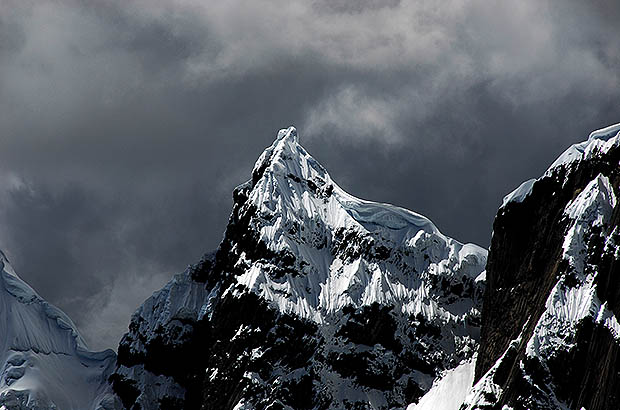
Bad weather is approaching the Santa Cruz Gorge, on the trail route of the same name
Of the most accessible and safe options for independent hiking in the Cordillera Blanca, I can list the following routes:
Trekking to the lagoon 96
From 3800 to 4600, without an overnight stay from Huaraz to Huaraz, or with one night in a tent on Lake Yanganuco - that one is on of the most popular routes in the Cordillera Blanca
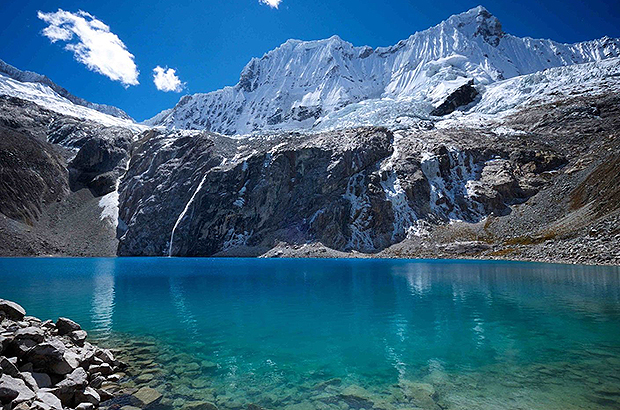
Lagoon 69 and the summit of Nevado Chakrarahu beyond it - one of the most famous, 'postcard' views of the Cordillera Blanca
Trekking to Ishinka base camp
From 3800 to 5200, with one or two overnight stays in a tent or Ishinka shelter on the Ishinka glade 4300 (I recommend not to go to any climbing routes outside the marked trails)

A rainbow over our base camp in the Ishinka glade. Descent after climbing Nevado Toclaraju
Trekking to Alpamayo Base Camp
From 3800 to 4300, two or three nights in a tent
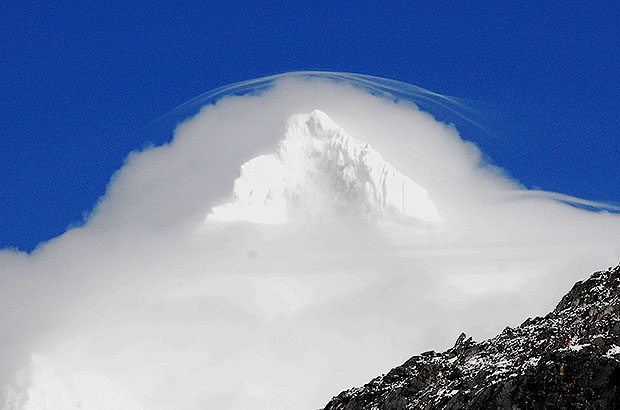
View of the top part of Nevado Alpamayo from the Alpamayo base camp
Trekking Santa Cruz
From 3800 to 4800 via the Punta Union pass, three or four nights in a tent

On the trekking route along the Santa Cruz valley towards the Punta Unión pass
Trekking to Huascaran Base Camp
Two days from 3200 to 4700, with an overnight stay at the Don Bosco shelter 4700. No independent attempts to the slope above the shelter are allowed.
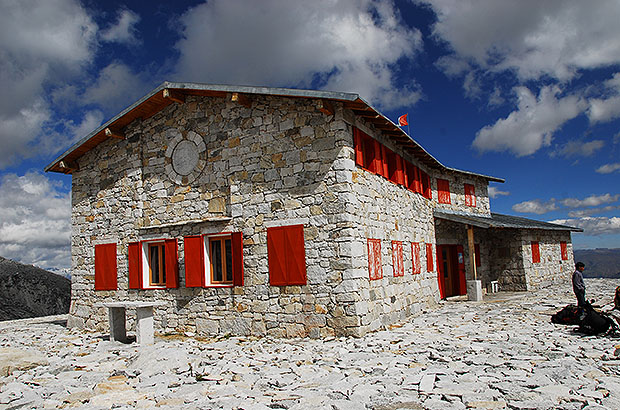
Don Bosco shelter on Nevado Huascaran - the end point of the trails and the beginning of the climbing route to the highest mountain in Peru
GPS Tracks and way points of these routes I can send on request.
In any case, to travel on these routes alone or in a weak group, you should follow the basic safety rules: have a detailed understanding of all parts of the route, including access to the beginning of the route. To have a navigation equipment, tracks and way points, coordinates of the overnight stays, thoughtful options for quick evacuation from the route.

The Peruvian police are always ready to help
It is advisable to register with the local police (definitely they will not be happy with your solo plans) and have a contact with an "accident commissioner" - a trusted person in Peru or outside, preferably a Spanish speaker, who will be aware of all the details of your plan and, who in case of emergency (your failure to return from the route within the agreed time) initiates the start of your rescue search.

Evening view of Huaraz - a town at an altitude of 3600 m, from where all ascents and trekking in the Cordillera Blanca begin
Please use this information with caution - not forgetting that even the simplest routes in the mountains can suddenly turn out to be more difficult and dangerous than you expect.
The author of the text and photos Alex Trubachev
Climbing guide and expert on the mountain regions of Peru and Bolivia
MCS EDIT 2023
Our Principles
AlexClimb Rule #1 - Safety First
From the very beginning of our activity, here nearly 16 years, the first Principle of work of School of mountaineering and rock-climbing of MCS AlexClimb is the Safety Priority. On the basis of this Principle all process of training is based, all programs and rounds are developed and carried out only within this main principle. We consider that at professional approach to development of programs, at personal discipline and correctly put motivation - occupations by mountaineering and rock-climbing are COMPLETELY safe. And from the return - all troubles and accidents in our sport come from nonprofessionalism, from ignorance or neglect by elementary standards of safety, from irrational motivation, from revaluation of own forces and opportunities. All these prerequisites we COMPLETELY EXCLUDE in our work - ours Rock-climbing, Ice climbing and Mountaineering are based on one Principle - the Safety Priority. In rock-climbing, mountaineering and ice climbing, the Priority of Safety of MCS AlexClimb-is your personal security and comfort irrespective of, than we are engaged - we train muscles and we work technology of the movement in the sports hall and on the rock climbing wall, we make the way through snowstorm to top or we relax on golden sand of the Caribbean beach after hot day of trainings on rocks. The Safety priority - the main credo of School of mountaineering and rock-climbing of MCS AlexClimb.
AlexClimb Rule #2 - Leave No Trace
Closely interacting with Nature, working with the active programs in mountains, woods, lakes and rivers, we perfectly understand the importance of carefull and respectfull bahavior towards the Nature, for its resources. From the very beginning of our outdoor-activity we adopted rules of Leave No Trace technique - the standard of behavior of the person accepted in all the civilized world in relation to environment and especially - to the wild nature. After all on the relation of people to the nature near which they exist, itself can draw dalekoidushchy conclusions on the relation of these people to... Where and as we didn't travel - we don't reserve any garbage, we try to reduce whenever possible our influence on environment to a minimum. We clear earlier zagryazyonny tourist parking of the left garbage, we take out and we take out to utilization places that to us other people left there. We consider that only thus, at personal individual consciousness of each citizen, each tourist, climber or autotraveller, we will be able to keep the nature surrounding us in its state, natural, suitable for life, - in it pledge of the healthy future for ourselves and our children.





